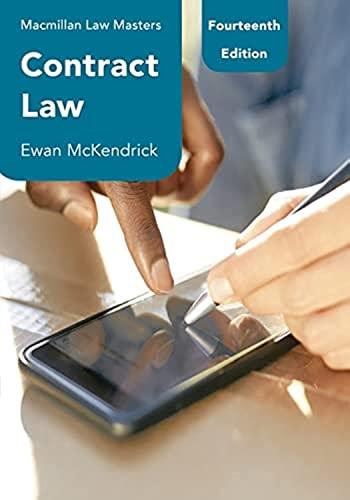Question
1. Baker v. Carr (1962) saw the Supreme Court enter a political thicket that it had been careful to avoid in the past. However, the
1. Baker v. Carr (1962) saw the Supreme Court enter a "political thicket" that it had been careful to avoid in the past. However, the politics of the decision extend beyond the fact that it dealt with reapportionment. How was the decision "political"? Refer to both the question of justiciability, and also to the politics of opinion-writing. How could Marbury v. Madison be understood as a "political" decision?
2. It is said that the landmark case, Lochner v. New York (1905), marked an era of "substantive due process economic protectionism." What does that mean and how could Justice Holmes criticize the court as a "superlegislature"? Was there another understanding of the significance of the Lochner case? Explain.
3. What are the different theories of where the power of Judicial Review should be housed, that are discussed in the text? Analyze.
4. Briefly describe at least three of the approaches to the Nationalization of the Bill of Rights under the 14th Amendment. Which approach do you agree with most and why? Imagine you are asked to represent a family who lost their child in a car accident involving a HUMMER. You move for a jury trial and appeal the case to the Supreme Court. Argue that the 7th Amendment should be incorporated to the states using one (or several) of the justifications mentioned above. Why should you be allowed a jury trial in your civil case.
5. Fresh from a stunning victory in the presidential election, President Biden begins work on a "Great Wall" along the border with Mexico. Almost immediately, he is confronted by a gun-toting, Bible-clinging, land-owner in Arizona, Ms. Leigh A. Graeme, who refuses to sell land that bisects the path of the wall. President Biden seizes the land and Ms. Graeme files suit, arguing that this amounts to a "taking" by the government and the case is heard by the Supreme Court. In particular, Ms. Graeme (who has a Doctor of Divinity degree from Liberty University and demands to be called "Doctor") argues that the land involved includes a shrine for "the Cross of the Eternal Flame," a 50-foot burning cross that stands on top of a hill and is visible from 40 miles in any direction. Dr. Graeme argues that the First Amendment protects her right to both free speech and free exercise of religion, and that the forced sell to the government of the property would violate those rights in addition to the being an unlawful "taking." You are Justice Aguado, the court's newest member and recent appointee during former President Trump's term in office, and are charged with writing the opinion for the majority. (Use your imagination to fill in the gaps, but remember that the primary thing is to show you read and can use the respective lines of precedent
Step by Step Solution
There are 3 Steps involved in it
Step: 1

Get Instant Access to Expert-Tailored Solutions
See step-by-step solutions with expert insights and AI powered tools for academic success
Step: 2

Step: 3

Ace Your Homework with AI
Get the answers you need in no time with our AI-driven, step-by-step assistance
Get Started


